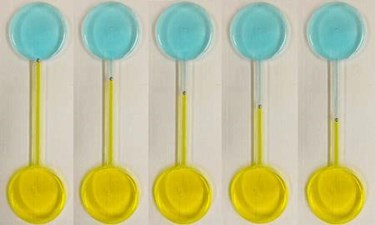Liquid Metals Make Fully Flexible Electronics A Reality
By Jof Enriquez,
Follow me on Twitter @jofenriq

Researchers at RMIT University in Melbourne, Australia have found out how to manipulate liquid metals bathed in water so that they create different electronic circuits. The development paves the way for malleable electronic circuits.
Computers, smartphones, and electronic devices rely on solid state components and rigid circuits with a fixed configuration. Researchers are experimenting with liquid metals with electroconductive properties to create flexible circuits that can be reconfigurable to execute different functions.
The RMIT team immersed the non-toxic liquid metal gallium in an electrolyte solution with acid, base, and salt components to enable the liquid metal to move autonomously. They used the alloy galinstan (gallium, indium, and tin) to make it more suitable for the experiment.
"Simply tweaking the water's chemistry made the liquid metal droplets move and change shape, without any need for external mechanical, electronic or optical stimulants," said Professor Kourosh Kalantar-zadeh, who led the group at the School of Engineering at RMIT, in a press release. “Using this discovery, we were able to create moving objects, switches and pumps that could operate autonomously – self-propelling liquid metals driven by the composition of the surrounding fluid."
When they made the water solution acidic, they observed that the droplets deformed inwards, while droplets bulged outwards in a base solution, according to Cosmos Magazine. Bulging increased when table salt (sodium chloride) was added. Using hydrogen chloride as the acid, and sodium hydroxide as the base and salt, the researchers produced switches and pumps by propelling galinstan droplets around in fluid-filled tubes. The liquid metal was made to move around by altering the electrical charge on its surface.
"Room-temperature liquid metals have shown to be remarkable platforms for makeshift mechanical components, reversible electrochemical systems, soft sensors, electrical components in microfluidic channels, three-dimensional printing, as well as stretchable and reconfigurable electronics," wrote the authors in Nature Communications, according to Motherboard. "Controlling the motion and deformation of liquid metals is the key to the successful realization of these applications."
The RMIT research could pave the way for myriad applications of flexible electronics in, for example, 3D displays, electronic devices, and biomedical components. By applying the study's principles, one might someday even create a real T-1000 Terminator metal humanoid, whose shape-shifting qualities helped sparked the idea behind the research.
The National Science Foundation (NSF) is finding ways to modify liquid metals into flexible and reconfigurable structures, such as antennas. According to NCSU researchers, liquid metals could greatly increase the range over which antennas' operating frequency can be tuned, compared to using solid conductors using electronic switches.
